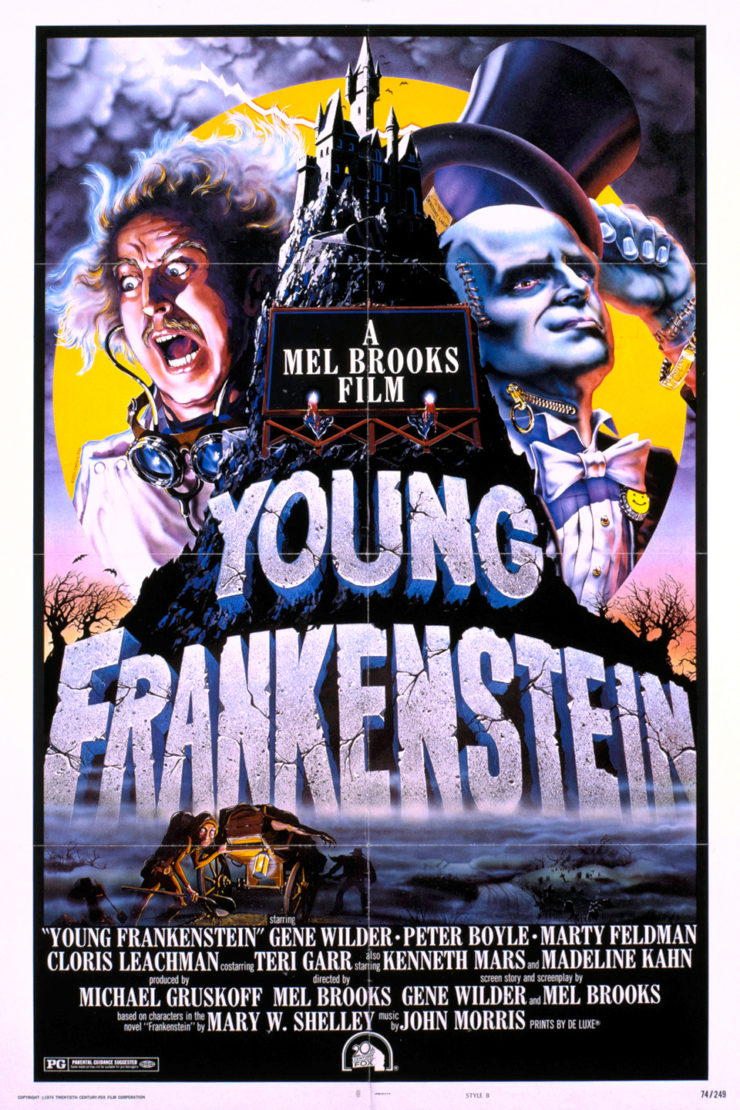No chipmunks were harmed in the making of this blog post, Tor.commers. OR WERE THEY?
Today’s entry in the Movie Rewatch of Great Nostalgia is that amazing sci-fi classic parody, Mel Brooks’ and Gene Wilder’s masterpiece of 1974, Young Frankenstein. Which, it took me entirely too long to realize, is the source of the music sting in that most dramatic of chipmunk clips linked above, even though I’ve been using it for dramatic punctuation for years. So sad.
Previous entries can be found here. Please note that as with all films covered on the Nostalgia Rewatch, this post will be rife with spoilers for the film.
And now, the post!
I moved to New York City in 2007, and following a hilarious and unlikely concatenation of circumstances which I will decline to share with you for Reasons, I ended up with an invitation to the November premiere of the Broadway adaptation of, you guessed it, Young Frankenstein. This was in fact the first Broadway play I had ever seen, on actual Broadway anyway, and maybe all the critics were not so pleased with it, but to me it was pretty damn amazing. It was a night I will never forget.
And the thing I remember most clearly about it (even more clearly than the after-party, which had rented out an entire floor of the Empire State Building, so understand what this is outshining) was at the close of the show, when the company ushered a frail-looking but brightly smiling Gene Wilder onto the stage, to receive a sustained standing ovation from the audience. I teared up to see him, the only time I ever saw him in person, and I didn’t even know why at the time.
I thought about that night and that reaction when I read about Gene Wilder’s death two weeks ago (and teared up again), and I think the answer as to why is pretty simple, really: I was seeing the twilight (and, later, the passing) of a person who had been an iconic figure in my childhood sphere of entertainment—and became so with really only two performances. One was Willy Wonka, probably his most famous role, and the other, of course, was Dr. Frederick von FRONKENSCHTEEN, in the 1974 film the Broadway play was based upon.
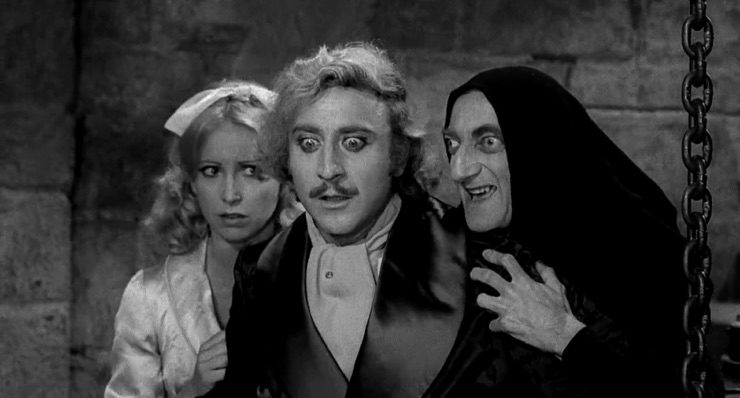
My sisters and I had a pretty good fight over which of the two we should choose to honor Gene Wilder’s passing on the MRGN, and Liz won with her insistence on Young Frankenstein. And ultimately I felt it was apropos, because even though as a kid it was neither my favorite Mel Brooks movie (that would be Spaceballs), nor my favorite Gene Wilder movie (that would be Willy Wonka & the Chocolate Factory, natch) I think that was not because either of those movies were actually better, but that as a kid Young Frankenstein was one of the few Mel Brooks films that was really rather over my head, and that I only truly learned to appreciate as an adult.
“Subtlety” is not something Brooks’ oeuvre is known for, generally, but Young Frankenstein has a depth and an odd sort of gravity to it, even among all the laugh-out-loud moments, that sets it apart from the rest of Mel Brooks’ films. And this is of course because it had such rich subject matter to draw upon, both in the classic films it was celebrating-slash-gently-mocking, and the ultimate source of it all, Mary Shelley’s novel, which has been and remains one of the most influential and enduring science fiction novels ever published, and which by some lights celebrates its 200th anniversary this year.
True, Frankenstein: or, the Modern Prometheus wasn’t published until 1818, but its conception dates to two years earlier, when Mary Shelley was only 18 years old. It remains a source of unmitigated glee to me, by the way, that the novel that arguably is the first true science fiction novel ever published was written by a teenage girl.
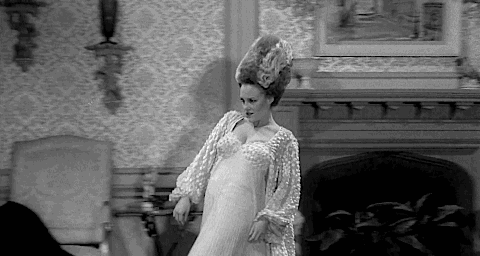
The other unexpected source of gravitas from watching this movie anew was realizing how many of its main cast, even aside from Wilder, are no longer with us: Peter Boyle, Marty Feldman, Madeline Kahn, Kenneth Mars… all have passed on. I don’t know why I was startled by this, seeing as the film is 42 years old, but, well. It just was startling, that’s all. It was equally startling to realize that Young Frankenstein is only a decade or so off from being as “old” a film to modern day kids as the original 1931 Boris Karloff Frankenstein was to me in the 80s. Talk about your sobering thought.
I suppose I should also admit at this juncture, guiltily, that though I have read the original novel, I have still never seen the entirety of either the 1931 Universal production of Frankenstein or any of its sequels. I’m not sure, though, that that is even necessary for me to have seen it, given how indelibly its most famous scenes have soaked into the gestalt of pop culture consciousness over the decades since its release—enough that even as a child, I recognized the broad strokes of what Young Frankenstein was parodying with little effort, even if I didn’t appreciate them nearly as much then as I do now.
It’s no surprise, really, that I should have identified it so easily, considering the countless times over the last century Frankenstein has been homaged, reimagined, riffed upon or parodied. I think it’s safe to say, though, that Mel Brooks and Gene Wilder’s take on it in Young Frankenstein is one of the more enduring and clever tributes to that legacy ever produced.
Because make no mistake: whatever else Young Frankenstein is, it is also incredibly funny. Not in a snappy, rolling in the aisles howling kind of way, but instead it is a leisurely, inexorable roll of snorts and chuckles the whole way through, with occasional blares of full-on laughter. And laughter, I have found, is the way people like to remember things best.
There are far too many classic comedic moments in the movie to list, of course, but my sisters and I have always had the biggest girl crush on Madeline Kahn, so naturally her scenes were our favorites. Not least because I had genuinely forgotten about this one:
She ducks the blown kiss, that is magnificent. I heart her so much.
The cast in general was a delight, especially since they were all playing such ridiculously exaggerated characters, and yet managed to make them all relatable and (more importantly) funny in their own right. Not to mention, they made a lot of jokes stick that by all rights should have fallen flat, just by how wonderfully they played off each other.
Though that is also due just as much to how those jokes were shot and edited. Timing is everything when it comes to comedy, and this film had an additional consideration: how to make the comedy work, while simultaneously successfully paying homage to the gloomy, creepy trappings of the early horror films it was parodying.
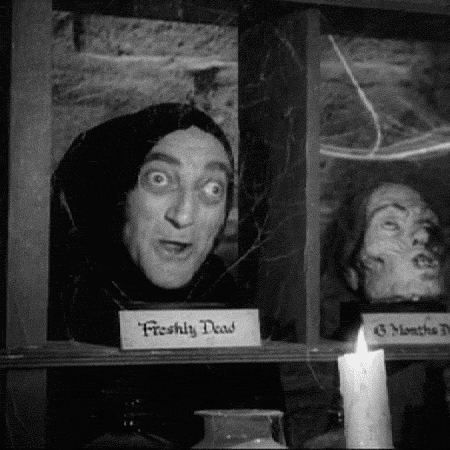
In this, the decision to shoot the film in black and white rather than color—a truly controversial decision at the time that almost cost the production its financing—was crucial to maintaining that balance. In my considered opinion the movie would never have worked in a million years had it been shot in color. It confused me as a child, having thoroughly absorbed the notion that black and white = boring and super old, but as an adult I thought it was a magnificent choice that made the movie work like nothing else would have.
One other thing I noticed as an adult, that I never did as a kid, was a note in the credits about the lab equipment:
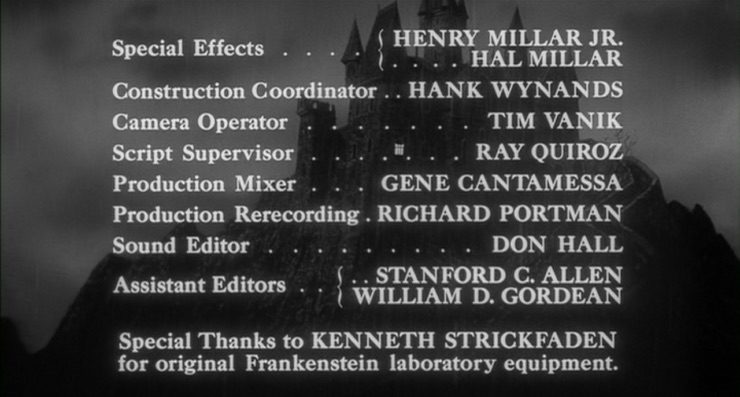
Seriously, that was the original equipment used on the set of the 1931 Frankenstein? Turns out it was! That is so cool. It was cool enough that I wondered what happened to the props after that, and found this clip from the early 1990s talking about it, but nothing after that. Like Leonard Maltin, I do hope that it found a good home.
Also, apparently, according to the Internet, the above note in Young Frankenstein’s credits is the first time Kenneth Strickfaden has gotten on-screen credit for his work, even though literally more than a hundred films from the 1930s on feature his unique designs for “mad scientist lab equipment”. That’s a tragedy, that his iconic work has gone so unnoticed, and I hope that in my small way this post can boost awareness of Mr. Strickfaden and the amazing work he did in shaping our visual concept of science fiction in the 20th century.
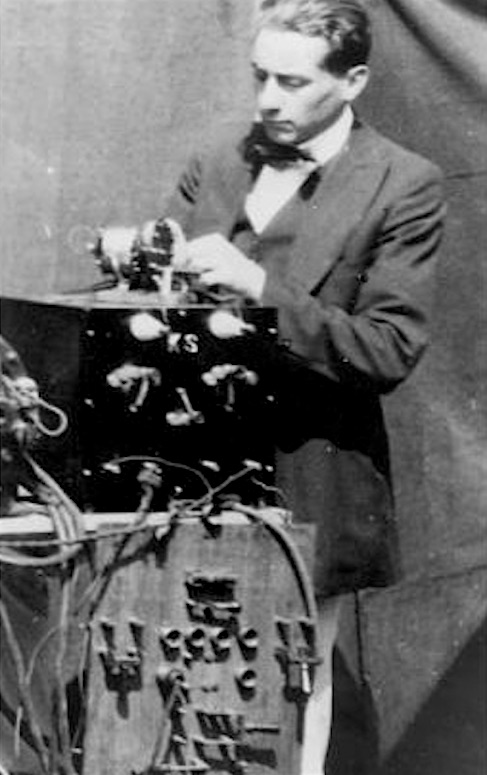
But all that aside, mostly watching Young Frankenstein this time around was about Gene Wilder, and watching him effortlessly carry this movie, with his odd and unique alternation between soft-spoken straight man and crazed yelling madman, to comedic greatness. And not just through his acting, it turns out; he co-wrote the script with Mel Brooks, and successfully fought Brooks on keeping in the scene which would become the most famous (and hilarious) scene of the entire film:
Like, you can even see why Brooks would have wanted to cut that scene, and yet keeping it in was a stroke of genius. On such decisions are iconic classics made.
Aaand there is so much more I could say about Gene Wilder and everyone else in this film and how they made it amazing, but instead I think I will leave it to you. Why is this movie a classic that everyone should see? What was your favorite bit? Tell us!
And then come back in two weeks for a film that I am personally incredibly excited to cover on the MRGN: Disney’s Watcher in the Woods! NERAK commands you to watch, eek! See you then!










